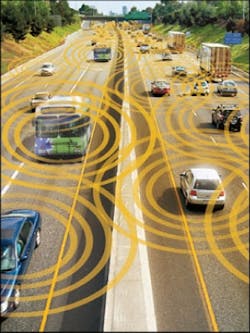This past August, the University of Michigan Transportation Research Institute (UMTRI) began a 12-month study on new vehicle-to-vehicle (V2V) technology in Ann Arbor, Mich. The study features nearly 3,000 cars equipped with a pilot version of the communication technology that OEMs are hoping will become a new standard in the industry.
Program manager and UMTRI associate research scientist Jim Sayer calls the research project, funded by the U.S. Department of Transportation, a “tremendous opportunity” to work on “cutting-edge transportation technologies.”
For repairers, it’s another example of the ever-changing features in vehicles, features that will soon make their way into shops across the country.
“You’re not going to stop technology,” says Chris Chesney, an instructor with CARQUEST Technical Institute (CTI). “Technology is driven by the consumer and their desire to have cool things. It’s driven by the economy, and it’s driven by the government in creating new fuel standards and emissions standards. There’s nothing we can do about it as shop owners but be ready for it and adjust for it.”
As part of his work with CTI, Chesney teaches a seminar about the “service bay of tomorrow.” And the idea that vehicle communication systems would evolve to the V2V level isn’t surprising, he says.
The V2V technology being tested comprises a connected wireless technology that allows vehicles to communicate with one another. The systems help vehicles avoid crashes and traffic.
While the technology is too young for repairers to begin training on, Chesney says there’s a simple way all shops can be ready for this, or any, new technology in the future: creating professional standards of practice in your business.
“It’s true today, it was true in the past, and it’ll be true tomorrow: There’s a lack of standards in our industry to be able to service vehicles,” Chesney says.
“You don’t have to have a license or prove your skills. … I believe that’s up to the individual shop and shop owner and technician to take that upon themselves and set their own standards.”
These standards, Chesney says, need to include expectations and requirements of employee training, education, procedures and performance. Keeping up with these standards will prepare a shop for whatever comes down the road, he says.
Brad Pellman, owner of Pellman’s Automotive Service in Boulder, Colo., has practiced this since opening his business as a one-man shop in 1996. As his shop grew, he required it of his employees.
One of his standards: He requires each of his technicians to undertake 80 hours of technical training each year. He also has required procedures for working on cars and less-technical requirements for education.
“It’s my job as a shop owner to ensure we can work on what comes in the door,” he says. “If it means doing research, that’s what we do. If it’s training, that’s what we do.”
Pellman’s training requirements have helped his shop keep up-to-date with any changing regulations. For instance, a change in fuel requirements may have gone unnoticed in 2011 if he hadn’t sent his techs to a fluids class that year where the changes were discussed.
“If you’re not doing that type of training regularly—even with something as simple as fluid updates—you’re not going to be aware of the changes until you make a mistake,” he says. “Then it’s going to hurt your business.”
Pellman, who serves as the education director for the Colorado chapter of the Automotive Service Association, estimates that only 30 to 50 percent of shops do sufficient training. Chesney guesses it’s a lot less.
Either way, they both feel that the shops with strong, defined standards for employees prepare themselves for any changes coming.
“I’m never worried about new technology, because we prepare for it every day,” Pellman says. “I can’t say that I’m up on V2V more than just knowing of it, but I guarantee you that when it comes into my shop, we’ll be ready to work on it.
“It’s not easy, but having the standards in place put you in the position where you can [be ready]. Otherwise, we’d just be lost.”
